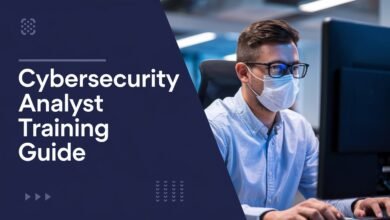As cyber threats escalate in frequency and sophistication, the landscape of cybersecurity is constantly evolving. The digital world we live in today demands that security measures not only respond to current threats but also anticipate future challenges. Technologies like artificial intelligence (AI), machine learning (ML), blockchain, and quantum computing are redefining how organizations protect their data, systems, and networks. But with new technologies come new risks. In this article, we dive into the cutting-edge trends and emerging solutions that will shape the future of cybersecurity.
Introduction: The Growing Complexity of Cyber Threats
With the rise of digital transformation across industries, the number and severity of cyberattacks are growing exponentially. In 2023 alone, ransomware attacks and data breaches affected millions, costing businesses and individuals alike billions of dollars in recovery. At the core of these challenges is the tension between evolving cyber threats and the technological innovations designed to combat them. As cybersecurity becomes a critical component of national security, business continuity, and individual privacy, it’s crucial to explore the technologies and trends that will define the future of defense in cyberspace.
AI and Machine Learning: The Future of Automated Threat Detection
Artificial intelligence (AI) and machine learning (ML) are rapidly becoming the backbone of modern cybersecurity defense mechanisms. Their ability to process vast amounts of data in real time and detect abnormal behavior sets them apart from traditional, rule-based systems.
- Automated Threat Detection: AI can quickly sift through enormous amounts of network data to identify anomalies that could signal a cyberattack. In fact, AI-driven cybersecurity systems are able to detect advanced persistent threats (APTs), identify zero-day vulnerabilities, and halt the progress of ransomware attacks more effectively than traditional security systems.
- Predictive Capabilities: Machine learning models can predict potential vulnerabilities by studying past attacks and malicious patterns, providing organizations with an early-warning system.
- Challenges: However, it’s not all smooth sailing. Cybercriminals have also started using AI to design more sophisticated malware and phishing attacks, making it a race between attackers and defenders. Moreover, AI’s need for extensive data training can raise concerns over privacy and bias, as well as make systems more vulnerable to adversarial attacks where hackers manipulate AI models.
Blockchain: Transforming Data Security and Identity Management
Blockchain technology, most widely known for its role in cryptocurrency, is now being explored for cybersecurity applications, primarily in securing data integrity and decentralized identity management.
- Immutable Ledgers: The decentralized nature of blockchain makes it difficult for hackers to alter data. Every transaction or data point is recorded in an immutable ledger, providing transparency and reducing the risk of tampering, especially in sectors like finance and healthcare.
- Decentralized Identity Verification: Blockchain can revolutionize identity management by allowing users to have more control over their data. This reduces the risks associated with centralized databases, such as identity theft and data breaches. By using decentralized identifiers (DIDs), individuals and organizations can manage their digital identities without relying on a single point of failure.
- Challenges: However, blockchain’s integration into cybersecurity is still in its infancy, and it faces challenges in scalability, integration with legacy systems, and energy consumption. Blockchain itself, while secure, can still be exploited in vulnerabilities within its surrounding systems, such as poor implementation of smart contracts.
Quantum Computing: A Double-Edged Sword
Quantum computing presents both enormous opportunities and challenges for cybersecurity. Its unparalleled computing power could be a game-changer for encryption—but also a threat.
- Quantum-Safe Cryptography: Quantum computing has the potential to break conventional encryption methods, such as RSA and elliptic curve cryptography, which currently secure much of the internet’s data. However, researchers are already developing quantum-resistant algorithms to protect data from these future supercomputers.
- Quantum Key Distribution (QKD): QKD offers a more secure method of encrypting communication. Using the principles of quantum mechanics, QKD ensures that any attempt to intercept an encrypted message alters the message in a detectable way, providing unparalleled security.
- Challenges: Quantum computing is still in its early stages, and while it poses a future risk to current encryption standards, widespread quantum computing is still years away. The current challenge is developing quantum-safe cryptographic algorithms before quantum computers become powerful enough to break today’s encryption.
Zero Trust Architecture: The New Norm for Network Security
Zero Trust Architecture (ZTA) is gaining widespread adoption as organizations move away from traditional perimeter-based security. ZTA assumes that no user or device, whether inside or outside the network, should be trusted by default.
- Micro-Segmentation: Zero Trust divides networks into smaller segments to limit the lateral movement of cybercriminals, should they breach the network. This creates a layered defense that makes it difficult for an attacker to access sensitive data or move undetected.
- Continuous Authentication: ZTA enforces strict identity verification protocols and access controls based on the principle of least privilege. Continuous authentication checks ensure that only verified users have access to certain network areas.
- Challenges: Implementing Zero Trust requires a fundamental shift in how organizations think about security. It can be complex and costly to integrate into existing systems, and maintaining the balance between security and user experience is difficult, especially in large organizations with global operations.
The Human Element: Education and Insider Threats
No matter how advanced technology becomes, human error remains one of the biggest vulnerabilities in cybersecurity. Insider threats—whether intentional or accidental—account for a significant portion of security incidents.
- Training and Awareness: Regular employee training is essential to prevent breaches caused by phishing, social engineering, and simple mistakes. Organizations must foster a culture of cybersecurity awareness that equips employees with the knowledge to recognize threats and respond appropriately.
- Behavioral Analytics: AI-powered behavioral analytics tools can help detect abnormal user activities that may indicate insider threats. By continuously monitoring user behavior, organizations can catch early warning signs before a breach occurs.
Conclusion: Preparing for the Future of Cybersecurity
The future of cybersecurity lies at the intersection of emerging technologies and an ever-evolving threat landscape. AI, machine learning, blockchain, and quantum computing are set to revolutionize how organizations defend against cyberattacks, but they also bring new risks that require careful management.
Organizations that stay ahead of these trends will be better equipped to protect their data, infrastructure, and people. Yet, the human element will always remain critical. No matter how advanced technology becomes, it will never fully eliminate the need for constant vigilance, continuous learning, and proactive adaptation to an increasingly complex digital world.
The future of cybersecurity is not just about keeping pace with cybercriminals but staying several steps ahead—leveraging new technologies while preparing for the next wave of challenges.
Published by CybaPlug.net: Your ultimate destination for tech news, gaming insights, and digital innovations.
Stay plugged in!
Hi I'm Olly, Co-Founder and Author of CybaPlug.net.
I love all things tech but also have many other interests such as
Cricket, Business, Sports, Astronomy and Travel.
Any Questions? I would love to hear them from you.
Thanks for visiting CybaPlug.net!





